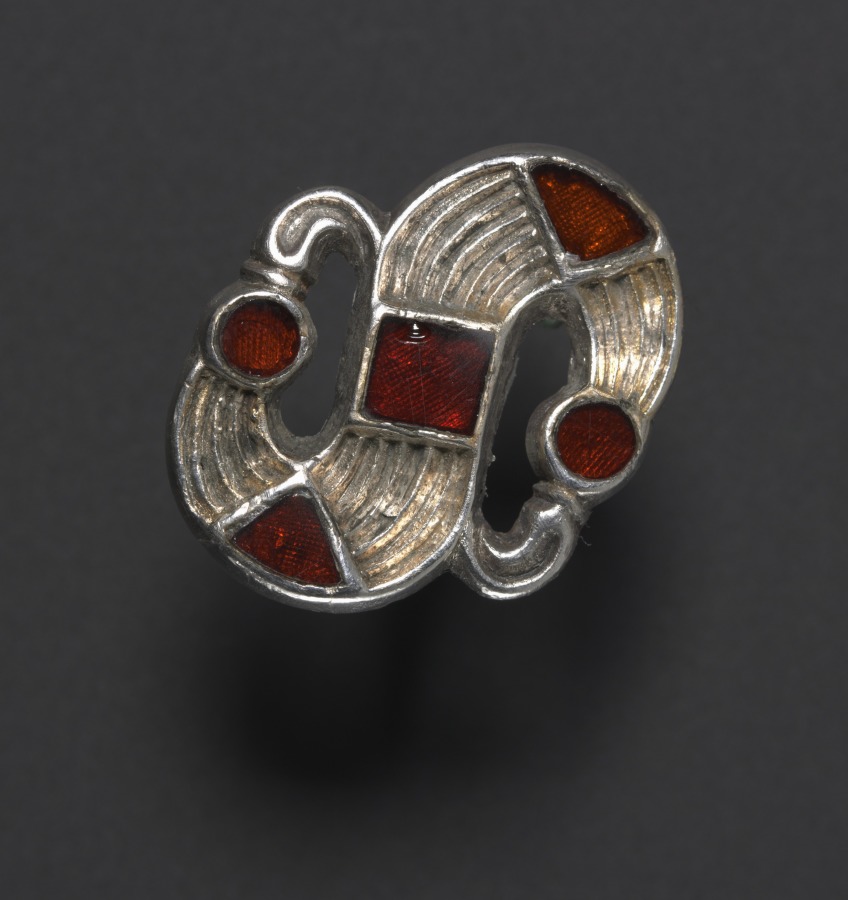
S-Shaped Fibula, Frankish, 6th c., silver with garnets, 2.2 x 2.8 x 0.8 cm. Cleveland Museum of Art, Gift of Joe Hatzenbuehler 2007.225
Despite the scholarly tendency to define medieval art through a stable set of easily recognizable images, the long Middle Ages witnessed variegated creative expression that pushes against the confines of such recognizability. One such push comes in complication — and sometimes outright rejection — of the figurative and the embrace of the abstract. How can one develop a framework for the consideration of such powerful — and yet rarely noticed — assault on figuration?
There are scores of medieval images — manuscript paintings, illuminated script, music notation, decorated jewelry — that do not fit in the clear cut-boundary of figuration, but instead lie in the realms beyond. Some are non-figurative, some non-representational, some abstract and others abstracted. These categories, of course, are not clearly defined. Abstraction can be found in ornamentation and geometric design, diagrams and patterns, script and swaths of color.
Such images often beg the consideration of layout, composition, scale, and viewpoint. When figurative and non-figurative forms merge, do they continue to hold figurative weight? Do some forms become “dis-abstracted”? What is the difference in considering abstraction in elements of an image as opposed to the overall composition? How do we reconcile a figurative foreground and non-figurative background? Does color signify on its own? Or does its significance emerge through its relation to a figurative image?
As a way of entering the fascinating world of medieval abstractions, we will propose, in the following posts, an overview of some of these and other questions through series of brief image analyses completed by students involved in the FACE project.
En dépit de la tendance historiographique qui établit l’art médiéval sur un lot stable d’images, facilement identifiables dans leur forme et dans leur contenu, on constate sur le long Moyen Âge une immense variété des formes d’expression qui mettent au défi la reconnaissance immédiate des motifs. La figuration se trouve altérée, parfois rejetée, au profit de manifestations que l’on qualifierait rapidement d’abstraites. Comment aujourd’hui concevoir un cadre d’analyse pour mesurer l’étendue de cette déstabilisation, parfois violente, de la figuration ?
Les images médiévales (enluminures, peintures, notation musicale, orfèvrerie) sont pourtant nombreuses à s’émanciper de la catégorie trop bien bornée de « figuration », à la dépasser en réalité pour s’installer au-delà de toute catégorie. Certaines ne figurent rien ; d’autres ne représentent pas ; d’autres encore sont soustraites au domaine de l’image ; d’autres enfin paraissent abstraites. On le sent, voilà des catégories bien flottantes… L’abstraction recoupe ainsi l’ornementation et les compositions géométriques, les diagrammes et les motifs, la graphie et les plages de couleur.
Ces images interrogent souvent les phénomènes de disposition, de composition, d’échelle et de point de vue. Quand les formes figuratives et non-figuratives se rejoignent, possèdent-elles encore une possibilité dans la figuration ? Est-ce que certaines formes « abstraites » peuvent redevenir figuratives ? L’abstraction affecte-t-elle l’image dans son ensemble ou bien peut-elle se limiter certaines de ces parties ? Comment réconcilier un premier plan figuratif et un arrière-plan non-figuratif ? La couleur signifie-t-elle seule ou sa signification vient-elle de sa relation à une image figurative ?
Comme voie d’entrée dans le monde fascinant des « abstractions médiévales », nous proposerons dans les billets suivants un panorama de ces questions à travers une brève série d’images analysées par les étudiants du projet FACE.







